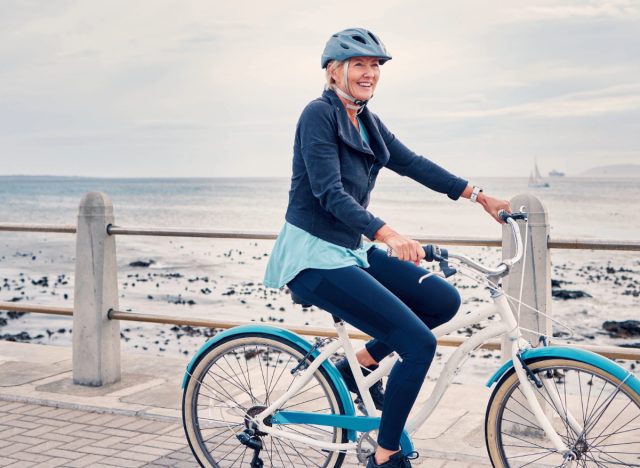This One Exercise Can Lead to Sexual Dysfunction in Women, Says Study

Cycling is one of the most popular forms of exercise and is only growing in popularity. According to the latest statistics, there are upwards of 50 million active cyclists in the United States. This is great news, of course, as cycling is well known to be an amazing, near-zero-impact activity that will work your heart and muscles while protecting you from stroke, heart attack, depression, obesity, and even some cancers.
And while experts have debated whether or not exercising on a bicycle seat can lead to sexual dysfunction in both sexes for a long time—and studies have indeed found that men who cycle a lot can experience impotence—a new study just published this month in the journal Sexual Medicine has some interesting takeaways for female cyclists. Read on for more about this study, and what it means for you. And for some great exercise advice, don't miss The Secret Side Effects of Exercising Before Breakfast, Says Science.
875 Female Cyclists Participated in the Study

The study was led by scientists at the University of California San Francisco, who recruited more 875 avid female cyclists from across the world—from the U.S., Canada, Australia, the UK, and New Zealand—to participate via a targeted Facebook campaign. The researchers devised a survey for the women, which included basic demographic data (age, race, weight, height, medical history, history of urinary tract infections, and lifestyle), as well as a series of questions regarding their genital numbness.
The participants were also asked about their cycling habits (duration, frequency, average speed, etc.), in addition to their setup. ("Do you wear padded cycling shorts when you ride?" "What type of bike do you ride the most?" "How do you usually fix the handlebar height?" What surface do you usually ride on?")
The primary purpose of the study was to look closely at any links between cycling and genital numbness among female cyclists, and the "secondary outcome" was to "evaluate the association of genital numbness with increased risk of reporting" female sexual dysfunction, which was measured using the Female Sexual Function Index (FSFI), a questionnaire that measures desire, arousal, orgasm, satisfaction, and pain, among other factors. And if walking is your exercise of choice, don't miss The Secret Cult Walking Shoe That Walkers Everywhere Are Obsessed With.
Here's What the Researchers Discovered

At the end of the study, the researchers found that "almost half of study participants self-reported genital numbness" as a result of cycling. Of those, 53% reported cases of mild numbness, and 70% of those cases were located around the vulva, specifically, which lasted for up to an hour. Among the age groups, younger cyclists—those in the 18-30 or 31-50 blocks (and not in the 51-65 or over-65 groups) were more likely to report feelings of numbness.
Not surprisingly, those who felt genital numbness were likely to ride longer and farther and at higher speeds than those who went on shorter, slower rides. Finally, women with a higher body-mass index, a history of UTI, or who utilized lower handlebars—the types found on road-racing bikes—were also more likely to report feelings of numbness.
Here's What They Found Regarding Sexual Dysfunction

"Genital numbness was found to be associated with higher odds of [female sexual dysfunction]," says the study, which notes that numbness and nerve compression are the main culprits. "The greatest associations between numbness and FSD occurred in those who reported localization of numbness to the perineum or numbness that lasted for a longer duration."
The study goes on: "We also found that cyclists who reported numbness also reported [higher] sexual pain scores… The results of our study… indicate that female cyclists are at greater risk of reporting genital numbness and symptoms suggestive of FSD and that genital numbness may be a predictive indicator of developing symptoms of FSD."
What It Means for You

If you're an avid cyclist, take note. If you're a far more casual cyclist, it's worth mentioning that the study participants were likely very active women, as they were recruited via social media due to their affiliation with sports clubs, and those who reported feelings of numbness tended to cycle quite a lot. Also, given that a high handlebar height was associated with less numbness overall, it's obvious that more serious and frequent road bikers—those who crouch lower and go farther and faster—are at risk of numbness and therefore report feelings of sexual dysfunction. (Also, the authors note the study's limitations, which did not include any lines of questioning regarding relationship satisfaction, stress, and mental health.)
That being said, it's clear from this study—and previous studies—that there are real risks with cycling frequently for long distances, and there are inherent risks—even if half of all women polled reported no symptoms of numbness whatsoever—with combining exercise and a bicycle seat, which the researchers note could potentially use a redesign. If you're an avid bike and you're experiencing any of the symptoms described in this study, consider seeking professional help. And for more exercise advice, check out The 7 Most Underrated Exercises You've Never Tried, Say Experts.








